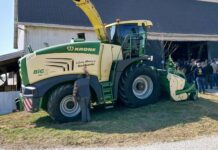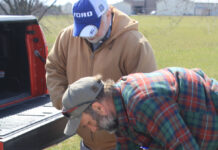They are out there. Inconspicuous and undetected, many buried underneath a hardened blanket of snow and ice, they are scattered throughout our Ohio woodlands. And they are waiting. Though winter has declared her reign, it will be only a few more weeks until these silent, dormant spaces tucked away on the forest floor will awaken to announce that spring has arrived.
Melted snow, spring rains and leaf litter will fill these once barren depressions. Hundreds of amphibians will emerge and migrate to them to secretly breed in the night. Algae, bacteria and thousands of organisms will gather here, weaving a lush and complex web of life.
Somewhere just beyond our back doorsteps exist these mysterious and magical vernal pools. Formed from indentations left by the glaciers, vernal pools are small, shallow pools of water. Most pools in Ohio are located either within woodlands or adjacent to them. Also known as temporary ponds, ephemeral ponds, or seasonal pools, vernal pools can be distinguished from rainwater puddles because they remain inundated longer, usually more than a couple of months. Unlike ponds and lakes, the water in a vernal pool will eventually dry up.
Hydrology
The hydrology of vernal pools (i.e., the source of water, change in water levels, and timing and duration of flooding) varies greatly. Some vernal pools fill with water in the spring and gradually dry up during the summer, while others might be fed periodically throughout the year by the upwelling of groundwater or by small springs. However, the most defining feature of a vernal pool is that they must fill with water seasonally and then dry up annually or every few years.
Since the presence of water in vernal pools is not permanent, the aquatic inhabitants must be able to adapt to temporary inundation and drawdown (i.e., lowering of the water level). Both flooding and the start of drawdown can serve as cues that trigger developmental changes in animals. For example, the shallower the pool gets, the warmer the water becomes. This is important to species which rely on thermal cues to hatch from eggs or to continue metamorphosis. Flexible life history strategies are imperative for survival in vernal pools due to the unpredictable length of time water is present.
Pool life
The filling and drying of vernal pools accommodates the life cycle changes of some species of frogs, salamanders and bugs. For example, most critters will be able to complete their life cycles in a vernal pool, unlike in a rainwater puddle, because the pools will retain water for months rather than days. At the same time, seasonal drying prevents fish from inhabiting vernal pools.
Fish are a prime aquatic predator and they eat nearly everything. Many amphibians would normally have a hard time maintaining a local population if their young were being picked off by hungry fish. Similarly bullfrogs, also hungry predators, will not normally use vernal pools since their tadpoles need to overwinter in water for one or two years before becoming adults.
Being abundant in food and void of these predators, vernal pools are essential breeding grounds and safe habitats for salamanders, frogs and macroinvertebrates.
Importance
Ohio has lost 90 percent of its original wetlands and a large percentage of these were vernal pools. The crucial role vernal pools play in the success of many species makes their potential for conservation and environmental stewardship significant. The habitat variability exhibited from pool to pool, as well as the great diversity of species that use them, make vernal pools an indispensable ecological link within the network of surrounding woods, lakes, ponds, and wetlands.
In Geauga County, the Geauga Soil and Water Conservation District has taken on the responsibility of monitoring and maintaining a complex of vernal pools created at the Pope Home site, a mitigation area owned by the Geauga Board of County Commissioners. As part of the mitigation banking effort undertaken by the county, the Pope Home site is available to offset the effects of development within the Cuyahoga River Watershed.
In other words, when a developer is given permission to fill in or impact a wetland by the Army Corps of Engineers, they may have to pay for that right by purchasing credits at a mitigation site, such as the Pope Home site.
Observation
Annual monitoring efforts are made by Geauga SWCD to ensure the vernal pools are achieving their biological and ecological potential. Thus far, they have been extremely successful, especially considering they were created where there were no vernal pools in existence previously.
The vernal pools at the Pope Home site are considered high quality wetlands, due in part to the presence of breeding wood frogs in the pools. Also present in the vernal pools are a diverse array of aquatic insects like water beetles, dragonflies, and caddisflies who help break down leaf litter and serve as a vital part of the food chain.
By summer’s end, when the glorious frog chorus becomes a soft woodland whisper, these vernal pools will once again start to vanish. But throughout the year in Northeast Ohio, the Geauga SWCD works hard to promote the protection and conservation of this critical habitat. Now, grab your flashlights and boots … the amphibians are about to return!
(Samantha Catella worked as a volunteer intern for the Geauga Soil and Water Conservation District, primarily doing field work in streams and wetlands. Now far from Geauga County, she is taking classes in Tibet while pursuing a degree in Molecular Environmental Biology at the University of California, Berkeley.)












